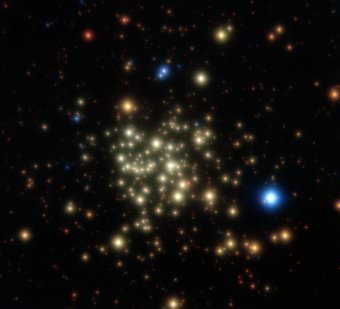Super-Size Me: Black Hole Bigger Than Previously Thought

Using a new computer model, astronomers have determined that the black hole in the center of the M87 galaxy is at least twice as big as previously thought. Weighing in at 6.4 billion times the Sun’s mass, it is the most massive black hole yet measured, and this new model suggest that the accepted black hole masses in other large nearby galaxies may be off by similar amounts. This has consequences for theories of how galaxies form and grow, and might even solve a long-standing astronomical paradox.
(...)
Read the rest of Super-Size Me: Black Hole Bigger Than Previously Thought (874 words)
Astronomers Find New Way to Measure Cosmic Distances

Using a rare type of giant Cepheid variable stars as cosmic milemarkers, astronomers have found a way to measure distances to objects three times farther away in space than previously possible. Classical Cepheids are stars that pulse in brightness and have long been used as reference points for measuring distances in the nearby Universe. But astronomers have found a way to use “ultra long period” (ULP) Cepheid variables as beacons to measure distances up to 300 million light years and beyond.
(...)
Read the rest of Astronomers Find New Way to Measure Cosmic Distances (862 words)
Podcast: Large Scale Structures in the Universe
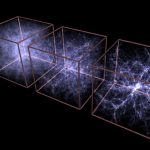
We’re thinking big. We’re going to consider the biggest things in the Universe. If you could pull way back, and examine regions of space billions of light-years across, what would you see? How is the Universe arranged at the largest scale? And more importantly… why?
Click here to download the episode.
Or subscribe to: astronomycast.com/podcast.xml with your podcatching software.
Large Scale Structures in the Universe- Transcript and show notes.
Podcast: Questions Show: Hidden Fusion, the Speed of Neutrinos a
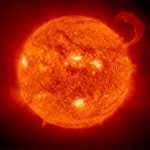
Are new stars dark until their photons reach the surface? How fast do neutrinos travel? And what’s the story with Hawking Radiation?
If you’ve got a question for the Astronomy Cast team, please email it in to info@astronomycast.com and we’ll try to tackle it for a future show. Please include your location and a way to pronounce your name.
Click here to download the episode.
Or subscribe to: astronomycast.com/podcast.xml with your podcatching software.
Questions show- Transcript and show notes.
Podcast: Questions Show: An Unlocked Moon, Energy into Black Hol
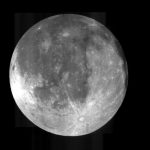
What would happen if the Moon wasn’t tidally locked to the Earth? What happens to all that mass and energy disappearing into a black hole? And how can we explain the space station’s crazy orbit?
If you’ve got a question for the Astronomy Cast team, please email it in to info@astronomycast.com and we’ll try to tackle it for a future show. Please include your location and a way to pronounce your name.
Click here to download the episode.
Or subscribe to: astronomycast.com/podcast.xml with your podcatching software.
Questions show- Transcript and show notes.
No Nature VS. Nurture for Stars
Stars don’t seem to mind where they grow up. Either in a nice quiet neighborhood or in the hellish environment near a supermassive black hole, astronomers were surprised to find the same proportions of low- and high-mass young stars in different types of star forming regions. Using the Very Large Telescope, astronomers snapped one of the sharpest views ever of the Arches Cluster — an extraordinary dense cluster of young stars near the supermassive black hole at the center of the Milky Way. “With the extreme conditions in the Arches Cluster, one might indeed imagine that stars won’t form in the same way as in our quiet solar neighbourhood,” says Pablo Espinoza, the lead author of the paper reporting the new results. “However, our new observations showed that the masses of stars in this cluster actually do follow the same universal law”.
(...)
Read the rest of No Nature VS. Nurture for Stars (402 words)
What If There Is Only One Universe?
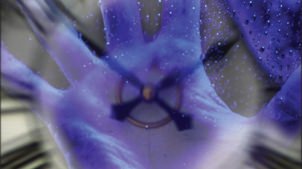
When it comes to universes, perhaps one is enough after all.
Many theories in physics and cosmology require the existence of alternate, or parallel, universes. But Dr. Lee Smolin of the Perimeter Institute for Theoretical Physics in Waterloo, Canada, explains the flaws of theories that suggest our universe is just one of many, and which also perpetuate the notion that time does not exist. Smolin, author of the bestselling science book ‘The Trouble with Physics’ and a founding member of the Perimeter Institute, explains his views in the June issue of Physics World.
(...)
Read the rest of What If There Is Only One Universe? (304 words)
NASA Science News for June 9, 2009
There's an email going around claiming that Mars will look as big as a full Moon on August 27th. Could this possibly be true? Find out in today's story from Science@NASA:
http://science.nasa.gov/headlines/y2009/09jun_marshoax.htm?list1035898
NASA Science News for June 3, 2009
Researchers are about to subject a fake astronaut complete with blood cells and simulated human tissue to an artificial solar flare. How the unlucky volunteer emerges from the radiation storm will reveal for the first time how much of a threat severe solar flares pose to astronauts en route to the Moon and Mars.
FULL STORY at
http://science.nasa.gov/headlines/y2009/03jun_fakeastronaut.htm?list1035898
NASA Science News for May 29, 2009
An international panel of experts has issued a new prediction for the solar cycle which takes into account the surprisingly deep solar minimum of 2008-2009. Read today's story to find out when they think solar maximum will return.
FULL STORY at
http://science.nasa.gov/headlines/y2009/29may_noaaprediction.htm?list1035898
Spaceships on the Move
!
Atlantis has begun her journey back home to the Kennedy Space Center, hitching a ride on the Shuttle Carrier Aircraft, a modified Boeing 747. The flight took off at about 11:05 EDT on Monday morning from Edwards Air Force Base, and the duo will fly to Biggs Army Air Field in El Paso, Texas and spend the night there before resuming the cross-country trip on Tuesday. Of course, Atlantis just returned from space, landing at Edwards on May 24, concluding the STS-125 mission to service the Hubble Space Telescope for the last time. Track the flight here.
But Atlantis isn’t the only spacecraft on the move. The shuttle Endeavour just rolled around to launchpad 39A, after standing down from its potential rescue mission, (STS-400) in case Atlantis was unable to return home, and now is preparing for the STS-127, which will hopefully launch around June 13. Watch the video of the rollaround below. And the next missions to the Moon are now poised for launch.
(...)
Read the rest of Spaceships on the Move! (158 words)
The Truth About NASA’s UFO Videos
Perusing You Tube, there are lots of UFO videos, which are usually grainy, shaky videos showing nothing that can be proved definitively. But there are a couple of videos that are different — and have generated a lot of interest — because they were filmed by NASA astronauts during space missions. I’d like to recommend everyone read an article published today by Popular Mechanics where the astronauts who were behind the camera for two of these videos speak out about what is actually in the videos, and NASA’s supposed “cover-up.” The two astronauts, Tom Jones and Mario Runco “reveal” what the videos are really showing. “There’s no way to keep people from using public domain footage for silly purposes,” former astronaut Tom Jones says in the article. “If a shuttle beams back 10 hours of Earth views each day, there are bound to be images and scenes that are misunderstood or taken out of context.”
(...)
Read the rest of The Truth About NASA’s UFO Videos (189 words)
Capture the Universe with Phil Plait

So, you think you’re a great astrophotographer? Then this is for you: the Bad Astronomer announced today he is hosting an astrophotography contest, sponsored by Discover Magazine and Celestron Telescopes. Phil himself will be the judge, so all you need to do is figure out what images he really likes and then get snapping! There are some great prizes:
Grand Prize: Celestron NexStar 8SE Computerized Telescope - Retail Value $1,399
One Runner-Up Prize: Celestron Axiom LX 31mm Eyepiece - Retail Value $399
One Viewer’s Choice: Celestron FirstScope – Retail Value $49.99
Read the rules and enter here. The only stickler-type rule is that the images need to be taken with Celestron equipment, but the contest runs from today (June 1) through June 30. Good luck to everyone, and I can’t wait to see all the images!
Have Astronomers Discovered A New Type of Supernova?
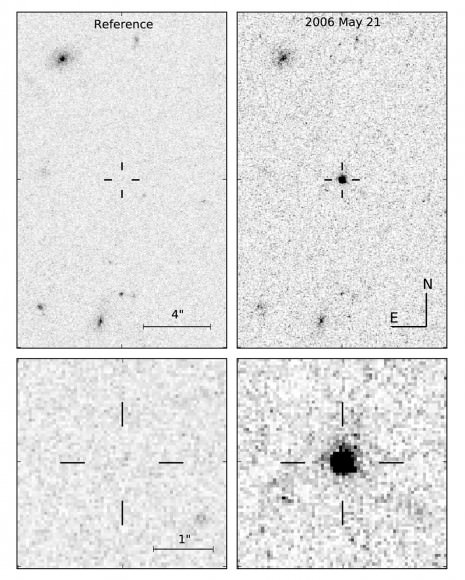
The sudden appearance of the transient "mystery object" SCP 06F6 in Hubble's field of view. The lower image quadrant represents a zoomed in view.
A team of astronomers at the University of Warwick think they’ve finally explained what caused the bizarre transient object SCP 06F6. By comparing the optical spectrum of SCP 06F6 to that of carbon-rich stars in our own galaxy, the team concludes the sudden outburst was not a low-energy local event but a supernova-like explosion within a cool carbon-rich atmosphere some 2 billion light years away. If they’re right, it means the collapse of carbon-rich stars may lead to supernovae unlike any yet seen.
(...)
Read the rest of Have Astronomers Discovered A New Type of Supernova? (372 words)
Carnival of Space #105
This week’s Carnival of Space is hosted by Ian O’Neill over at Discovery Space. Yes, Ian is at the Space Disco — if you’re confused, read this.
Click here to read the Carnival of Space #105
And if you’re interested in looking back, here’s an archive to all the past carnivals of space. If you’ve got a space-related blog, you should really join the carnival. Just email an entry to carnivalofspace@gmail.com, and the next host will link to it. It will help get awareness out there about your writing, help you meet others in the space community - and community is what blogging is all about. And if you really want to help out, let Fraser know if you can be a host, and he’ll schedule you into the calendar.
Finally, if you run a space-related blog, please post a link to the Carnival of Space. Help us get the word out.
